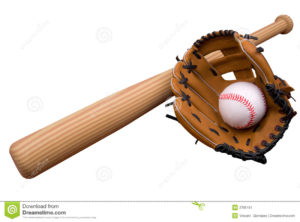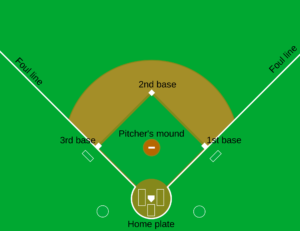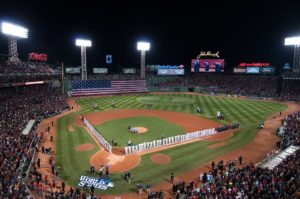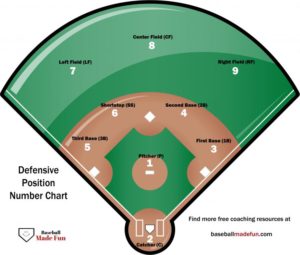America’s Pastime
Well, OK, football too. But it’s baseball season, about 40 games in (1/4 of season), and there is no better way to while away a summer afternoon or evening. So for those who would like a somewhat deeper understanding of the game, here is a short series that will enhance your enjoyment.

Baseball vs everything else
Baseball is fundamentally different from all the other “major” team sports: football, soccer, basketball, hockey, lacrosse. 1 The basic difference is this: in all the other sports, the ball (or puck) is used by the offense to score points, by bringing the ball or puck to a predetermined location: the end zone, net, hoop, goal. In baseball, the ball belongs to the defense; it is put in play by the centerpoint of the defense, the pitcher; the offense, to score, must do so in spite of the ball; in fact, the ball is pure poison to the offense. Players are only immune at one of the safe points, called bases, and the very best outcome for a batter is to launch that poisonous ball completely out of the stadium! 2
Another major difference, with baseball and football on the same side of the divide this time, is that, unlike hockey and its ilk, baseball and football are discontinuous. In the other sports, play is continuous, interrupted only for events such as goals, penalties, or out-of bounds. Both baseball and football have discrete quanta of play. In football, this unit of play is called, imaginatively, the play. It begins when the center hikes the ball, and ends when the ball or carrier is down, at which point play stops, the pile of bodies is untangled, the dead are carted off the field, and the weary players shamble back to the huddle. In baseball, the unit of play is the pitch. 3 It begins when the pitcher throws the ball, and ends…well, this gets a bit involved. This brings us to the last fundamental difference:
Baseball has no clock
Football, hockey, basketball, soccer: all of these are timed games. Typically, there is one hour of actual play, interrupted by timeouts or play interruptions. 4 Football, in particular, seems to run from timeout to timeout at times, especially near the ends of games. 5Each game has a means of determining a winner if the score is tied after “regulation”: timed overtime in basketball and hockey, sudden-death (a method of debatable fairness) in football, and the dreaded penalty kick in soccer. 6 Baseball is not timed. At all. There is no clock anywhere on the field in Major League baseball. The game is played for nine innings (more on this later), and if tied, extra innings are played. There are no official time-outs. 7Time-outs in baseball are casual, quick things: a runner has slid into second base, keeps his hand on the base until he gestures to the umpire for time-out, the ump calls time out, the batter can stand up, brush off the dirt…game on!
All these games have built-in methods to keep up the pace: basketball has the 24-second clock, football has the 30-second scrimmage, hockey…doesn’t need to worry about it, you don’t even dare blink in a hockey game. In baseball, the pace is more leisurely, or at least it seems that way. If there is truly a delay in the play (the pitcher stares down the batter, the batter stops to readjust his batting gloves, the pitcher adjusts his cap, the batter adjusts his crotch), the umpire will step in and tell them to get on with it…at the ump’s discretion. 8
Substitutions
In baseball, unlike the other sports, when a player is removed from the game, the player is out for good. There is no in-and-out substitution, as there is in football or hockey.
One more thing
Football season consists of 17 games. Baseball season is 162 games.
The field of play

The inner field, or infield, is known as the diamond, though it is really a square turned 45 degrees. The infield is the diamond, and the surrounding dirt area. The distance between bases is 90′; the distance from the pitcher’s mound to home plate (“the plate”) is 60’6″. The live-play field is the area between the first base and third base baselines, extending all the way out to the walls that mark deepest points of the outfield. Where the lines meet the wall, there are foul poles, to make it possible to tell if a ball in the air is in fair or foul territory. The distance from the plate to the outfield walls is typically 300-400 feet. All stadiums differ in the outfield dimensions; there is no standard.
 Fenway Park in Boston.
Fenway Park in Boston.
There are nine players per side; the nine players for the defense are shown: The numbers are used for keeping track of defense; for example, a double play (more later) from the shortstop to the second baseman to the first baseman is a 6-4-3 double play. There is no offense/defense platoon: all players have to both field and bat (with one exception). 9
The numbers are used for keeping track of defense; for example, a double play (more later) from the shortstop to the second baseman to the first baseman is a 6-4-3 double play. There is no offense/defense platoon: all players have to both field and bat (with one exception). 9
There are four umpires, one at each base. The home plate umpire is responsible for calling balls and strikes; more on this later.
The Teams
Major League Baseball (MLB) consists of 30 teams, grouped into two leagues, the American League (AL) and the National League (NL). Each league consists of three divisions: East, Central, and West, divided roughly geographically. Each division has five teams, for thirty teams total. Most games are played between teams in the same league. The World Series pits the leading AL team against the leading NL team. Until recently, these were the only games played between the leagues, but now each team plays a few games against teams in the other league; this is called interleague play. 10
The rules are the same in each league, with one important exception: the NL does not use the designated hitter, whereas the AL does. This will be covered in the section on offense.
The Game
A game consists of nine innings. A full inning consists of the “visiting team” coming up to bat, with the “home team” on defense, followed by the home team at bat, and the visitors on defense. The first half of the inning, with the visitors batting, is often called the “top” of the inning; the homer team’s at bat is the “bottom”. Each team tries to score as many runs as possible (that is, advance as many players as possible from home to first to second to third and to home again) before three “outs” are made. 11 The details of how this is done will be covered in subsequent posts.
One more, vitally important, rule: The Force
This has nothing to do with Star Wars! If you try to watch a game without understanding this rule, you may feel lost.
There are situations where a baserunner is required to advance to the next base, and other situations where it is optional. The rule is this: if a runner is required to advance, ie if the runner is forced, the defender with the ball need only touch the base (with any part of the body, usually the foot) for the runner to be out. If the runner is not required to be at the base, the defender must touch the runner with the ball, or with the glove with the ball inside.
Example: there is a baserunner at first base. The batter hits a ground ball. The runner at first base is forced to run to second, because he needs to leave first empty for the batter. Thus, the second baseman need only touch second base, with the ball in his possession, before the runner arrives; the runner is then “out”. Instead, if the runner is starting at second base, and the batter hits a ground ball, the runner is not forced to run; he could stay at second, because first base is still open for the batter to run to. However, he may wish to run to third base, but in this case, the third baseman will need to tag the runner directly, usually with glove containing ball, before the runner arrives. We will see more of this, and one more force situation (involving fly balls), in the Offense section.
Future posts
The next post will cover offense, in two sections: batting and baserunning. The subsequent post will cover defense, again in two sections: fielding and pitching. The last post will cover some typical baseball statistics and awards.
- I will make frequent comparisons, in these early sections, between baseball and football, in a thoroughly non-judgmental way.
- It is worth noting here that only one player can occupy a base at a time.
- The average NFL game has 128 plays. The average MLB game has 292 pitches. And they say baseball is slow-paced! (It is; more on this later.)
- These are few in soccer, hockey and basketball.
- Great for advertisers.
- Which is far, far worse than even the sudden-death.
- It is time-out if the ball leaves the field of play, for example if a foul ball is hit into the grandstand; time will restart when the pitcher has a new ball. Again, no clock.
- Minor League baseball has a pitch clock that the pitcher must follow. This will get to the Majors soon; it is only a matter of time. Haha.
- In sharp contrast to football, where offense and defense are separate teams. I wonder how different football would be if players had to play both sides of the ball; I suspect it would be improved.
- There is also the All-Star Game, played in July, which pits the best players from each league against the other.
- Football is “Risk!”; baseball is “Sorry!”.
